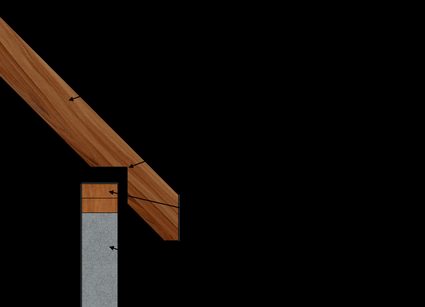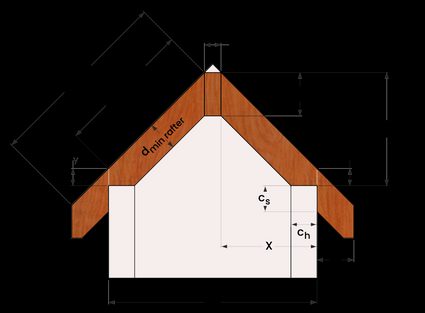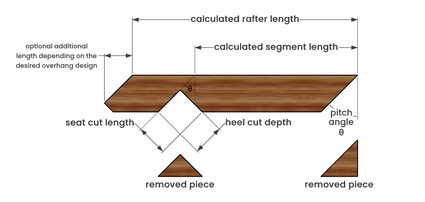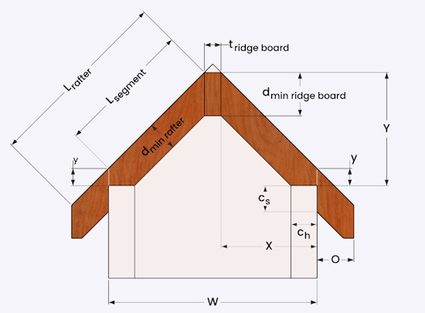Birdsmouth Cut Calculator
Table of contents
What is a birdsmouth cut?How to find the essential dimensions when cutting a birdsmouth on a rafterHow to use this birdsmouth rafter cut calculatorHow to cut a birdsmouthFAQsThis birdsmouth cut calculator will be your quick guide when constructing a rafter system with a birdsmouth cut or even if you just want some help with your birdsmouth rafter cut calculations.
In this birdsmouth calculator, you'll learn:
- What a birdsmouth cut is;
- How to find the essential dimensions when cutting a birdsmouth on a rafter;
- How to use this birdsmouth rafter cut calculator;
- How to cut a birdsmouth; and
- Some frequently asked questions about birdsmouth rafter calculations.
Read through our article below to learn how to cut a birdsmouth cut.
🔎 If you need to find how much material to use for your roofing, you'll find our roofing calculator useful.
What is a birdsmouth cut?
A birdsmouth cut is a notch on the underside of the rafters that provides a surface for the rafter to neatly and safely rest on top of the supporting wall while keeping the overhanging part of the rafter intact.
The rafters support the roofing materials, and adding a birdsmouth cut on each rafter helps the rafter effectively transfer the load of the roofing materials to the beam or wall beneath them.
Below is a sample image showing a rafter with a birdsmouth cut:

To appropriately design a birdsmouth cut, we first need to familiarize ourselves with the different dimensions present in a roofing rafter system that utilizes the birdsmouth cut, as shown in the image below:

In the next section of the text, we'll discuss these parts and the different formulas we use to determine their measurements.
How to find the essential dimensions when cutting a birdsmouth on a rafter
Before we head on to the birdsmouth calculations, we first need to have a quick overview of the rafter system we will construct.
To do that, let us first determine the horizontal distance where the segment of our rafter will sit on or the rafter segment run we denote as , as shown in this equation:
where:
- — Roof rafter run;
- — Building width; and
- — Ridge board thickness.
We can then multiply our roof rafter run by the tangent of the roof pitch angle, , to find the roof rafter rise, , as shown in this equation:
Now is also the best time to find the length of the rafter segment, , as indicated in the image below.
To calculate , all we have to do is divide our roof rafter run, , by the cosine of our roof pitch angle, as we can see in this equation:
If we know the roof's overhang distance, , we can find the total rafter length, , by dividing the overhang distance by the cosine of our roof pitch angle and then adding the quotient to . Here is the equation for the total rafter length:
🙋 You can learn more about rafters in our rafter length calculator.
Now that we already have an idea of how our rafters are going to look, we can now find the different dimensions of our birdsmouth cut, starting with the heel cut depth:
where:
- — Heel cut depth; and
- — Seat cut length.
The heel cut is the vertical cut we perform on the underside of the rafter to create the birdsmouth cut.
On the other hand, the seat cut is the horizontal cut of the birdsmouth or the cut that will come in contact with the wall's top plate. In essence, we can say that the rafter sits on top of the wall's top plate.
The top plate's width is typically the same as the wall's thickness, and we usually want a seat cut length equal to the wall's top plate. Sometimes, we can use a seat cut length less than the wall thickness.
According to the International Residential Code, our rafter material should have a depth of at least four times the heel cut depth. In equation form, we can express that as:
where:
- — Minimum rafter depth.
By dividing the minimum rafter depth by , we can find the minimum ridge board depth, , as shown in this equation:
By following the geometry of the rafter and its birdsmouth cut, we can also calculate the shortest vertical distance above the seat cut to the upper side of the rafter material or the height above the plate we denote as by subtracting the heel cut depth from the minimum ridge board depth, as we can see in this equation:
The birdsmouth rafter cut calculation may be daunting after knowing we need a lot of formulas to remember. But worry no more because this birdsmouth cut calculator is here to the rescue! Keep on reading to learn how to use this birdsmouth cut calculator.
How to use this birdsmouth rafter cut calculator
To use this birdsmouth rafter calculator, you can follow these steps:
-
Enter the width of your building.
-
Input the thickness of the ridge board you plan to use. We typically use 1-inch ridge boards, but we can also use thicker ones for larger roofs.
-
Type in your roof's pitch angle. Alternatively, you can also enter the roof pitch percentage or the roof pitch ratio instead, depending on the information you know. You can also check our roof pitch calculator to explore the topic of roof pitch more.
-
Next, enter the seat cut length of your birdsmouth cut.
-
Then, input the length of reach of your desired overhang on our birdsmouth cut calculator.
-
Finally, click on the Results heading of our birdsmouth cut calculator to display the values for the rafter run and rise, rafter segment length, total rafter length, heel cut depth, the minimum rafter and ridge board depths, and the height above the plate.
In the next section of this text, let's briefly discuss how to apply these dimensions and learn how to cut a birdsmouth cut.
How to cut a birdsmouth
Cutting a birdsmouth cut requires a variety of angle cuts. Shown in the image below are some of the angle cuts that are basically at the angle the same as the roof pitch angle:

Here are the steps you can follow to cut a birdsmouth cut:
-
From the upper end of the board (the right-side end of the board in the image above), draw a line at an angle the same as the roof pitch and cut along that line using a miter saw. You can read more about the miter saw in our miter angle calculator.
-
Measure the calculated segment length from the pointy tip of the board and draw the same angled line from that point.
-
Measure the heel cut depth from the lower end of the line, and then, using a speed square, draw a perpendicular line from that angled line to draw where the seat cut will be.
-
Double-check the length of this new line. That should be equal to your seat cut length.
-
Cut through those lines to complete the birdsmouth cut.
-
Measure again from the pointy tip of the board and mark the rafter length from our birdsmouth calculation to consider the overhang. From that mark, draw the same angled line or a perpendicular line across the board for the lower end of your rafter.
💡 If angle cuts interest you, we have our angle cut calculator that you can check.
What are the purposes of a birdsmouth cut?
The purposes of birdsmouth cut are the following:
-
Helps give the rafter a horizontal surface that will evenly come in contact with the supporting wall;
-
Supports the rafters in place so they won't slide down during installation; and as an
-
Expression of craftsmanship, when done correctly.
How do I find the heel cut depth of a birdsmouth cut?
To find the heel cut depth for a birdsmouth cut with, let's say, a 4-inch seat cut:
-
First, determine the roof pitch angle, θ. Let's say
25°. -
Then, multiply the seat cut length by the tangent of the pitch angle to find the heel cut depth.
For our example, that would result in:
heel cut depth = seat cut length × tan(θ) = 4 inches × tan(25°) ≈ 1.865 inches.
What is the minimum ridge board depth for a 12-inch rafter depth?
The minimum ridge board depth for a rafter with a depth of 12 inches that we should use for a roof with, let's say, a 35-degree pitch angle is 14.65 inches or around 15 inches. We get that value by dividing the rafter depth by the cosine of the roof pitch angle to have:
12 inches/cos(35°) = 14.64929 inches ≈ 14.65 inches.
Is birdsmouth cut necessary?
For timberworks, utilizing the birdsmouth cut helps in the integrity of a rafter system. However, we should constantly observe and follow the guidelines in our building code to ensure that we don't notch our rafters deeply, which would compromise their strength and the safety of our structures.

